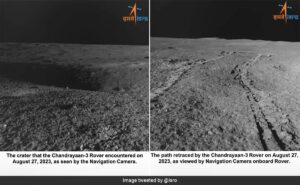
Earendel is a name from the world that J.R.R. Tolkien established in his novels such as The Lord of the Rings, and it means’ morning star’ or ‘rising light’ in old English. It comes from the world that Tolkien developed in his writings such as The Lord of the Rings. Astronomers have given this name to a newly discovered star, which also happens to be the furthest distant star that has been observed to date, in an amusing bit of symbolism. It is estimated to be 12.9 billion light-years away from us, which is an incredible distance.
Because of a phenomenon known as “gravitational lensing,” the discovery, which was published in the journal Nature, was the result of rigorous studies over nearly four years, made possible by the phenomenon known as “gravitational lensing.”
The light from a star that is one light-year away would take one year to arrive at our location on the planet. As a result, the astronomers are witnessing the star Earendel as it existed 12.9 billion years ago in its current form. The discovery of one of the earliest stars, born less than a billion years after the Big Bang, if verified by further research by the James Webb Space Telescope, would mark the beginning of the search for the origin of the universe. It is possible that it is composed of raw elements, in contrast to the stars that formed considerably later in time — for example, our Sun, which is just 4.5 billion years old and originated from dust and gas.
In a press release posted on NASA’s Hubble website, astronomer Brian Welch of Johns Hopkins University in Baltimore, who is the corresponding author of the Nature paper, said that studying Earendel would be like opening a window into an era of the universe that we are unfamiliar with but that led to everything we know. According to Welch, “It feels like we’ve been reading a great interesting novel, but we’ve just gotten to the second chapter, and now we’ll have a chance to discover how it all got started.”
Gravitational lensing is a type of optical illusion
It was only because of a process known as gravitational lensing that it was possible to observe this specific star. Gravity bends light from a star or galaxy when it approaches a huge object, such as another galaxy, a black hole, or any other enormous entity. This is well known in the scientific community. As a result, the image of the light source may appear distorted in comparison to the original. Gravitational lensing is the term used to describe these phenomena. Similar to how an optical lens in a magnifying glass amplifies the characters on a page, distortion caused by gravitational effects may magnify the object under consideration.
Gravitational lensing has a variety of consequences, including the following: For example, if the original object, such as a giant star or galaxy, lies exactly behind a gigantic galaxy, the intervening galaxy will have four images on each of its four sides. This results in four brilliant spots in the image, which are collectively referred to as Einstein’s cross, as a result of the process.
As long as the original object is not directly behind the intervening galaxy, but is slightly off-center, the image created will have the appearance of being curving or arcing.
The Arc of the Sun
This was the first thing the researchers saw. They observed an arc of light that they determined to be a lensed image of a very old galaxy. Further investigation and study of this arc, which they dubbed ‘The Sunrise Arc,’ revealed the image of Earendel to them.
“At this distances, galaxies typically seem as little smudges, with the light from millions of stars mixing together to form a uniform appearance. As a result of gravitational lensing, the galaxy that hosts this star has been amplified and warped into a long crescent-shaped structure that we have designated as ‘the Sunrise Arc.'”
So, how did the astronomers manage to get a good look at this star?
It is a matter of chance
It was purely by accident that it happened. In the distance between us and Earendel, there is a massive galaxy called WHL-0137-08, which acts as a powerful gravitational lens, warping the universe around it and distorting and magnifying the light from things in its vicinity. Because of this technique, whereas the galaxy to which Earendel belongs was normally magnified as an arc, the star alone had its size magnified to more than one thousand times its original size. Because the starlight happened to travel across a ripple in space-time generated by the distorting impact of the intervening galaxy, astronomers believe this is the cause. A ‘caustic’ is a type of ripple that looks like this. Earendel’s picture is magnified and brightened to the greatest extent possible when he is lying on the caustic.
When scientists report the results of their observations, they are always cautious, and in the case of the sighting of Earendel, they included in the study the variables about which they are unsure about their findings. For starters, the object that they detect and name Earendel could actually be a binary or a cluster of stars rather than a single star. They could be much closer than they think if it is not actually part of the Sunrise Arc but only looks to be such since it is a part of it. More observations, as well as independent observations, will be required to confirm all of this.
Source: The Hindu



